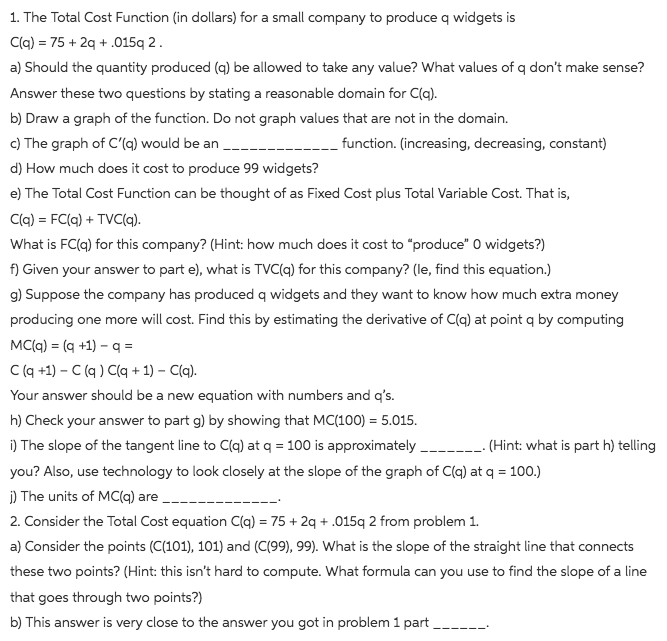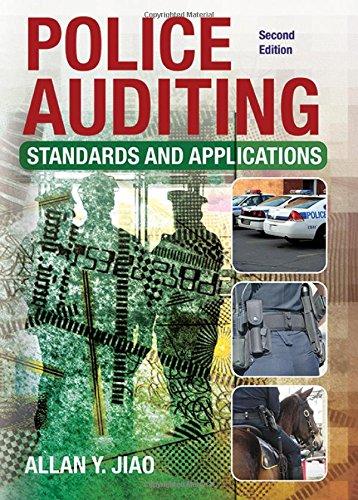For the problems i just posted I only need help on question 1 G,H,I,J and question 2 A,B

1. The Total Cost Function (in dollars) for a small company to produce a widgets is C(q) = 75 + 2q +.0159 2. a) Should the quantity produced (q) be allowed to take any value? What values of q don't make sense? Answer these two questions by stating a reasonable domain for C(q). b) Draw a graph of the function. Do not graph values that are not in the domain. c) The graph of C'(q) would be an function. (increasing, decreasing, constant) d) How much does it cost to produce 99 widgets? e) The Total Cost Function can be thought of as Fixed Cost plus Total Variable Cost. That is, C(q) = FC(q) + TVC(q). What is FC(q) for this company? (Hint: how much does it cost to "produce" O widgets?) f) Given your answer to part e), what is TVC(q) for this company? (le, find this equation.) g) Suppose the company has produced a widgets and they want to know how much extra money producing one more will cost. Find this by estimating the derivative of C(q) at point q by computing MC(q) = (q +1) - = C(q +1) - C(q) Clq + 1) - Clq). Your answer should be a new equation with numbers and a's. h) Check your answer to part g) by showing that MC(100) = 5.015. i) The slope of the tangent line to Clq) at q = 100 is approximately (Hint: what is part h) telling you? Also, use technology to look closely at the slope of the graph of C(q) at q = 100.) D) The units of MC(q) are 2. Consider the Total Cost equation Cla) = 75 + 2q +.0159 2 from problem 1. a) Consider the points (C(101), 101) and (C(99), 99). What is the slope of the straight line that connects these two points? (Hint: this isn't hard to compute. What formula can you use to find the slope of a line that goes through two points?) b) This answer is very close to the answer you got in problem 1 part 1. The Total Cost Function (in dollars) for a small company to produce a widgets is C(q) = 75 + 2q +.0159 2. a) Should the quantity produced (q) be allowed to take any value? What values of q don't make sense? Answer these two questions by stating a reasonable domain for C(q). b) Draw a graph of the function. Do not graph values that are not in the domain. c) The graph of C'(q) would be an function. (increasing, decreasing, constant) d) How much does it cost to produce 99 widgets? e) The Total Cost Function can be thought of as Fixed Cost plus Total Variable Cost. That is, C(q) = FC(q) + TVC(q). What is FC(q) for this company? (Hint: how much does it cost to "produce" O widgets?) f) Given your answer to part e), what is TVC(q) for this company? (le, find this equation.) g) Suppose the company has produced a widgets and they want to know how much extra money producing one more will cost. Find this by estimating the derivative of C(q) at point q by computing MC(q) = (q +1) - = C(q +1) - C(q) Clq + 1) - Clq). Your answer should be a new equation with numbers and a's. h) Check your answer to part g) by showing that MC(100) = 5.015. i) The slope of the tangent line to Clq) at q = 100 is approximately (Hint: what is part h) telling you? Also, use technology to look closely at the slope of the graph of C(q) at q = 100.) D) The units of MC(q) are 2. Consider the Total Cost equation Cla) = 75 + 2q +.0159 2 from problem 1. a) Consider the points (C(101), 101) and (C(99), 99). What is the slope of the straight line that connects these two points? (Hint: this isn't hard to compute. What formula can you use to find the slope of a line that goes through two points?) b) This answer is very close to the answer you got in problem 1 part







